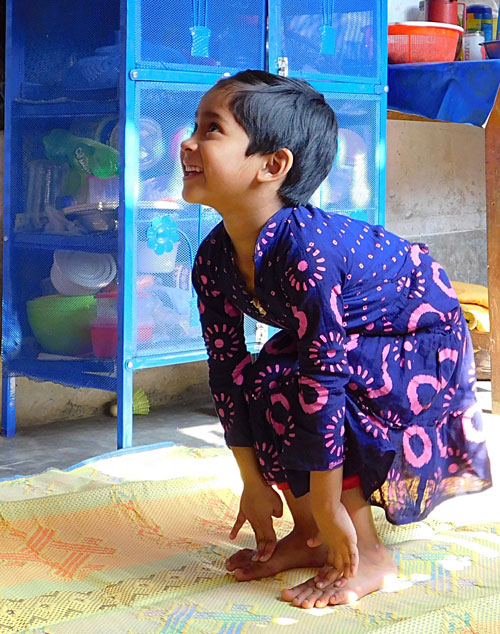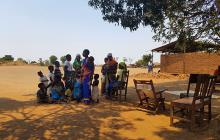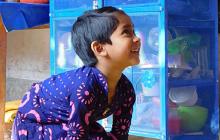Effective Pre-Primary Education Programs: Lessons Learned from Bangladesh and Mozambique
 Many countries have made universal access to pre-primary education a priority in recent years. Pre-primary education—often called pre-school or kindergarten—takes place during a major developmental period in a child’s life, typically ages 3 to 5. It can help reduce equity gaps by providing children with similar opportunities to learn, and by promoting further education. For example, in some developing countries, on-time enrollment in grade 1 is an issue; but when children participate in pre-primary education, they are much likelier to enroll in grade 1 on time.
Many countries have made universal access to pre-primary education a priority in recent years. Pre-primary education—often called pre-school or kindergarten—takes place during a major developmental period in a child’s life, typically ages 3 to 5. It can help reduce equity gaps by providing children with similar opportunities to learn, and by promoting further education. For example, in some developing countries, on-time enrollment in grade 1 is an issue; but when children participate in pre-primary education, they are much likelier to enroll in grade 1 on time.
As governments like those in Bangladesh and Mozambique look to bolster their education systems, they hope to invest in programs that are backed by evidence. In Bangladesh, children who are 5 years old have universal access to one year of pre-primary education, and the country’s education plans call for expanding that access to two years (for ages 4 and 5). AIR researchers used a randomized controlled trial to assess the effects of providing a second year of the Early Years Preschool Program on child development outcomes. The goal was to provide the government with evidence on the program’s effectiveness.
In Mozambique, education leaders have considered how to expand access to pre-primary education and help ensure that children who participate succeed in their later education. AIR researchers conducted a mixed-methods experimental evaluation of the Accelerated School Readiness pilot program to determine whether and how the program improved outcomes for children, quantify the costs of the program, and identify factors that helped or hindered the program’s success.
Other countries hoping to expand access to quality pre-primary education can learn from the experiences of Bangladesh and Mozambique; specifically, some of the necessary conditions to make pre-primary education programs effective.
Components of Effective Pre-Primary Education Programs
While there are many factors that are important, here we highlight four qualities for education leaders, program funders, and policymakers to consider, based on AIR’s research.
1. Play-based learning
Globally, it is widely accepted that play-based learning is the most effective methodology for young children. In many developing contexts, however, play-based learning is still unfamiliar to parents and educators, and pre-primary classrooms follow the model of primary school. In some instances, this is because parents and educators didn’t experience play-based learning themselves as children, and when they think of learning, they picture students sitting quietly in a row of desks. To them, play-based learning might feel chaotic, like it is “just playing,” as opposed to having educational value. Local experts and educators may need to advocate with government, educators, and parents so that they understand how play-based learning can best support their child’s healthy development.
In the U.S., there are concerns about “fade out”—in other words, that programs like Head Start give children an initial boost academically, but after a few years, those positive effects subside as their peers catch up. This may be because students who don’t attend pre-school often still have access to other resources—quality day care, programming like Sesame Street, and so on—that end up filling in the gaps.
In developing contexts, fade out occurs less often. This could be because there are fewer supplemental resources available; students who don’t attend pre-school may have no other school-preparation resources to fill that gap.
2. Educator pay and value
Early care and education providers in many countries are very underpaid compared to other professions. One reason for this issue is the often common view that women have always been responsible for raising children, meaning that no special expertise is needed for pre-primary educators. However, in order to run an effective program, educators must understand child development, have the training and skill to run a play-based program, and stay in the profession long enough to make real use of that training. When they are underpaid, pre-primary teachers often can’t afford to stay in their positions, which results in high turnover; and because it is undervalued, they often don’t want to. For example, in some countries, people view working in early care and education as a stepping stone to office-based jobs in other fields. It can be challenging to establish a dedicated, well-trained workforce under those circumstances. It is not only developing countries that are working through these issues; in the United States, high staff turnover due to low pay is a persistent problem in early care and education settings.
3. Infrastructure
It’s a common misconception that learning instruments like desks and uniforms are essential for any education programming, but these items are not necessary in pre-primary education. However, some infrastructure is necessary: a classroom that is protected from the elements, has adequate light and air circulation, and adequate space for the children to work or play. Children and teachers also need handwashing stations, and other facilities that promote hygiene and sanitation. Above all, the classroom and grounds need to be safe. Hands-on learning, or play-based learning, also requires materials—such as books, crayons, and puzzles. They don’t all have to be store-bought, but it is important to have sufficient materials for all children in the class to engage in learning (rather than losing educational time while waiting around for their turn).
4. Sustainability
A previous trend in offering pre-primary education was to do so through small scale pre-primary programs provided through nongovernmental organizations or religions institutions. Those programs may work well for the children who get to participate, but they are often costly to operate and require resources (such as trained teachers and dedicated classrooms) that would not be feasible to provide at scale. This approach can keep pre-primary education separate from government education systems, making it difficult to scale up or hand off to governments to eventually operate. The goal should be to create a quality pre-primary education program that doesn’t require constant infusions of external funding, and can be run, sustainably and at-scale, using only government resources. Accelerated programming is one model that has worked well in Mozambique and is currently being piloted in a number of other countries.
 In the weeks before children start grade 1—what we’d call summer break in the U.S.—the children gather in the local school building for a sort of mini-kindergarten. Depending on the country, it’s taught either by community volunteers or primary education teachers. For about six weeks, the children acclimate to their language of instruction, if it’s different from their home language; they get used to basic school activities: numbers, letters, books, and even hand-washing and taking turns. This doesn’t replace an entire year of high-quality, comprehensive pre-primary education, but it has shown lasting beneficial effects in Mozambique. And because it uses existing infrastructure—teachers, classrooms, even latrines—it can be feasibly scaled and sustained by governments.
In the weeks before children start grade 1—what we’d call summer break in the U.S.—the children gather in the local school building for a sort of mini-kindergarten. Depending on the country, it’s taught either by community volunteers or primary education teachers. For about six weeks, the children acclimate to their language of instruction, if it’s different from their home language; they get used to basic school activities: numbers, letters, books, and even hand-washing and taking turns. This doesn’t replace an entire year of high-quality, comprehensive pre-primary education, but it has shown lasting beneficial effects in Mozambique. And because it uses existing infrastructure—teachers, classrooms, even latrines—it can be feasibly scaled and sustained by governments.
When it comes to international pre-primary education, quality is just as important as quantity. Children do not experience benefits from lower-quality programs; in fact, they sometimes experience adverse consequences. The other major consideration for education leaders, policymakers, and program funders in developing contexts is equitable access to quality programming. Many countries have age-appropriate pre-primary programs—but only the children of the wealthy have access. In those cases, pre-primary education serves to exacerbate inequities, when it really should be helping to bridge them. The good news is, we know what works, which is half the battle.


